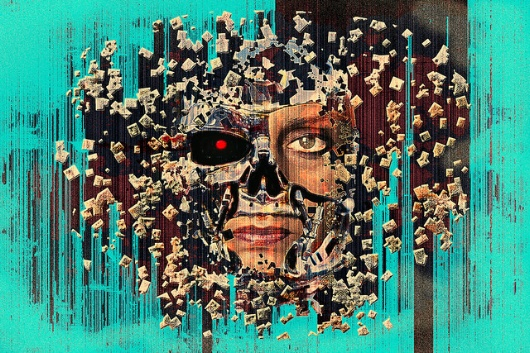Deus ex Machina
Editor's Note: This is the second essay in our series on relationships between religion and science fiction
Editor's Note: This is the second essay in our series on relationships between religion and science fiction. Read the first issue, Audrey Thompson's "'Cross'-examining the Biblical Witness in War for the Planet of the Apes," and look for more in the coming weeks.
 Back in 2015, when Silicon Valley golden boy Anthony Levandowski quietly filed the articles of incorporation for a nonprofit called Way of the Future, he was best known as a rising star of the self-driving car industry and a charismatic, if slippery, entrepreneur. Levandowski is only one among thousands of AI specialists with grandiose visions of a robotically enhanced future. But the nature of his particular enthusiasm only became clear in September, when Wired broke the story of Way of the Future, a religious organization that aims, according to its 2015 filing, to “develop and promote the realization of a Godhead based on Artificial Intelligence and through understanding and worship of the Godhead contribute to the betterment of society.” The language in the filing is ambiguous, whether intentionally or otherwise: the “realization” of the Godhead might refer either to the discovery of a preexisting Godhead or to the work of building it. The explicitly theological language is unusual, but the idea of a transcendent AI is not. The possibility of an AI that is in some respect transcendent is hardwired (so to speak) into ongoing debates about the Singularity, the (hypothetical and cloudily defined) point at which machine intelligence surpasses humans’ ability to understand it. While the sages of the technosphere are divided on whether we should face this encroaching future with fear or gladness, there is broad consensus that the Singularity—whatever it is—is coming.
Back in 2015, when Silicon Valley golden boy Anthony Levandowski quietly filed the articles of incorporation for a nonprofit called Way of the Future, he was best known as a rising star of the self-driving car industry and a charismatic, if slippery, entrepreneur. Levandowski is only one among thousands of AI specialists with grandiose visions of a robotically enhanced future. But the nature of his particular enthusiasm only became clear in September, when Wired broke the story of Way of the Future, a religious organization that aims, according to its 2015 filing, to “develop and promote the realization of a Godhead based on Artificial Intelligence and through understanding and worship of the Godhead contribute to the betterment of society.” The language in the filing is ambiguous, whether intentionally or otherwise: the “realization” of the Godhead might refer either to the discovery of a preexisting Godhead or to the work of building it. The explicitly theological language is unusual, but the idea of a transcendent AI is not. The possibility of an AI that is in some respect transcendent is hardwired (so to speak) into ongoing debates about the Singularity, the (hypothetical and cloudily defined) point at which machine intelligence surpasses humans’ ability to understand it. While the sages of the technosphere are divided on whether we should face this encroaching future with fear or gladness, there is broad consensus that the Singularity—whatever it is—is coming.
Like any technologically powered advance, the notion of a computational, manmade god upheld by Way of the Future has plenty of antecedents in science fiction. Omniscient digital deities such as AM in Harlan Ellison’s “I Have No Mouth, and I Must Scream” and the massively networked cybernetics machine of Fredric Brown’s “Answer” began to surface in science fiction from the 1950s onward, after the genre’s midcentury shift toward large-scale thinking about human history. This generic shift, powered in large part by the ambitions of the influential magazine Astounding’s editor John W. Campbell, moved science fiction away from pulpy adventure stories and toward more conceptually ambitious reckonings with human history on a cosmic scale.
The shift began in earnest with Isaac Asimov’s Foundation series (the first installment of which was initially published as a series of short stories in Astounding between 1942 and 1950), which was inspired by Gibbon’s Decline and Fall of the Roman Empire. Asimov’s classic series takes cues from the newly emerging discipline of psychohistory to imagine large-scale movements in human civilization and culture, and posits its own version of the discipline that enables statisticians to predict the future, albeit in a generalized way. Though Asimov’s psychohistorians are human, the practice of psychohistory is computational, requiring the coordination of many kinds of data and information across a broad range of metrics. In this way, the nature and the scope of Foundation’s ambitions paved the way for the celebration, even the deification, of the computer. Like the Godhead anticipated by Way of the Future, the divine or proximately divine computers that emerge from this imaginative sphere inaugurated by Foundation attain that status by the sheer speed and scope of their computational power; in worlds that exceed the grasp of the human mind by their vastness, an entity that can comprehend and synthesize the great quantity of data is, indeed, a kind of god.
But if the deity imagined by Way of the Future resembles the omniscient synthesizers of the post-Foundation era, the closest analogue for the organization itself appears much earlier. E. M. Forster’s novella The Machine Stops, in which the titular Machine’s human residents eventually begin to worship it, predates the first Foundation story by more than thirty years. Forster’s story is a chronicle of humanity’s last days, a period of ever-increasing dependence on an all-encompassing Machine that provides for every aspect of their underground lives, supplying food, music, and mediated social encounters that are “good enough for all practical purposes.” Eerily prescient in its anticipation of social networking, The Machine Stops offers a dystopic vision of an interconnected world of displaced experience in which a thinned-out, mediocre version of every experience is instantly and easily available. The story opens roughly ten years before that final collapse, at a point when the human race has largely cured itself of the desire or expectation for direct experience, and follows it through to the bitter, pitiful end.
The advanced society that inhabits the Machine is far too civilized to have any truck with religion proper: in the words of protagonist Vashti, who has embraced the advanced values of her age, “there is no such thing as religion left. All the fear and superstition that once existed have been destroyed by the Machine.” But throughout the story, Vashti engages in a variety of devotional practices toward the Machine, including the veneration of its instruction manual, and struggles even to grasp the “unmechanical” ideas of her son Kuno before rejecting them. In the final years of the Machine, practices such as Vashti’s become publicly affirmed and codified, and the Machine’s grateful denizens develop elaborate praise rituals and affirm to one another the feelings of peace and ecstasy they gain from their interactions with it.
In contrast to midcentury stories of divinized computers, the Machine of Forster’s story is not sentient. The faceless Central Committee who maintain the Machine and manage its interactions with residents are a nightmare of modern bureaucracy rather than an extension of the Machine itself. Nor are they particularly nefarious, any more than is the Machine itself. When the committee moves, toward the end of the story, to institute reverence toward the Machine and abolish the respirators that allow for limited surface travel, it does so only in response to the “invincible pressure” of a citizenry that desires the changes. “To attribute these two great developments to the Central Committee,” the narrator explains, “is to take a very narrow view of civilization.” The Machine and its bureaucracy are both the impetus and the mechanism for these restrictions of free movement and free exercise of belief, but the choice to restrict these putatively outdated freedoms is a choice for, of, and by the very people whom it imprisons.
Like the authors of sentient-AI stories, we live in an age that conceives of power in terms of information synthesis. The Way of the Future is, in some respects, already the way of the present; in this brave new world increasingly shaped by “smart” technologies, stories like Ex Machina or Her may speak more directly to our present hopes or fears than the sprawling automated honeycomb of Forster’s Machine. But Forster’s story recalls a point that flashier technologies, and the stories about them, eclipse: any machine can be a prison if we choose to lock ourselves in. As the reach of AI extends further into the our public and private lives—and does so, increasingly, at the directives of actual and aspiring authoritarian leaders—the role of human beings in negotiating their own relationship to the machines is more important than ever.
Resources
- Brown, Fredric. “Answer.” First published in Angels and Spaceships. New York: E.P. Dutton, 1954.
- Ellison, Harlan. “I Have No Mouth, and I Must Scream.” First published in IF: Worlds of Science Fiction, March 1967.
- Ex Machina. Directed by Alex Garland. A24 / Universal Pictures, 2015
- Forster, E. M. “The Machine Stops.” First published in The Oxford and Cambridge Review, November 1909.
- “Foundation [series].” The Encyclopedia of Science Fiction. September 17, 2013.
- Geraci, Robert. Apocalyptic AI: Visions of Heaven in Robotics, Artificial Intelligence, and Virtual Reality. New York: Oxford University Press, 2010.
- Harris, Mark. “God is a Bot, and Anthony Levandowski Is His Messenger.” Wired. September 27, 2017.
- Her. Directed by Spike Jonze. Warner Bros., 2013.
- Nevala-Lee, Alec. Astounding: John W. Campbell, Isaac Asimov, Robert A. Heinlein, L. Ron Hubbard, and the Golden Age of Science Fiction. New York: Dey Steet Books / HarperCollins, forthcoming 2018.
- Tufekci, Zeynep. “Sleepwalking into Surveillant Capitalism, Sliding into Authoritarianism.” DrupalCon 2017. April 27, 2017.
Image: "Artificial Intelligence" | Credit: GLAS-8/Flickr (cc)
 Author, Emanuelle Burton (PhD’14), is a scholar of literature and ethics who focuses on the interrelationship of self and world in nonrealist genres. In addition to her solo scholarship, she is working with computer scientists Judy Goldsmith and Nicholas Mattei to develop a science-fiction-based ethics curriculum for computer science students. She is one of this year’s contributors to the Craft of Teaching program’s blog. Author, Emanuelle Burton (PhD’14), is a scholar of literature and ethics who focuses on the interrelationship of self and world in nonrealist genres. In addition to her solo scholarship, she is working with computer scientists Judy Goldsmith and Nicholas Mattei to develop a science-fiction-based ethics curriculum for computer science students. She is one of this year’s contributors to the Craft of Teaching program’s blog. |
SIGHTINGS is edited by Brett Colasacco (AB’07, MDiv’10), a PhD candidate in Religion, Literature, and Visual Culture at the University of Chicago Divinity School. Sign up here to receive SIGHTINGS via email. You can also follow us on Facebook and Twitter.

